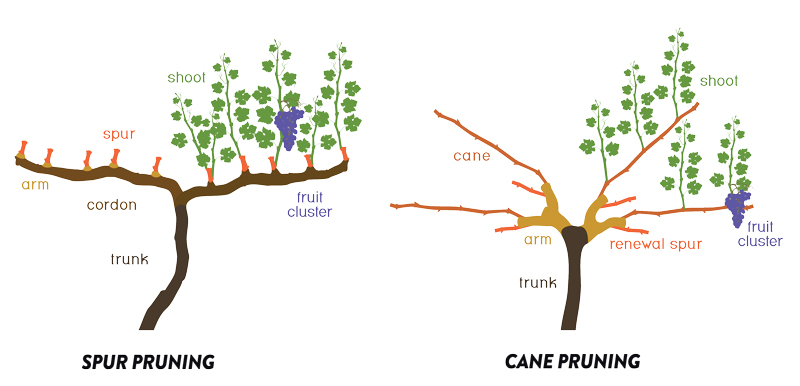What’s old is new again at our estate Margarita Vineyard, as we continue to convert the bulk of our vines from cordon spur pruning to cane pruning.
“Cane pruning has been around for thousands of years, but cordon spur pruning became prevalent in the modern wine industry,” says co-owner and viticulturist Doug Filipponi, noting that Margarita Vineyard was originally 100 percent cordon spur pruned.
“More and more, however, you’re seeing a shift back to cane pruning,” Doug says. “At Ancient Peaks, we’re doing it for two reasons: it elevates fruit quality and it prevents vine disease. It’s more costly and labor intensive to do cane pruning, but we like the payoff.”
Cordon vs. Cane
With cordon spur pruning, the vine is trained so that two “arms” (or sometimes just one) are allowed to grow horizontally from the trunk. These arms, called cordons, become a fixed part of the vine. From these arms, new canes—or vine branches—grow each year. Then, after harvest, all of the canes are cut back to their nubs (called spurs), leaving just a few buds per spur. It is these buds that push the following year’s canes, and the cycle begins anew.
With cane pruning, there are no fixed cordons. Each year, two or more canes are selected, while the rest are pruned away. These remaining canes contain numerous buds. These buds push the new canes and fruit for the season, and then the process is repeated the following year. As one observer puts it, “Cane pruning takes great skill to do well because it requires manually cutting back nearly all of the vine’s prior growth and correctly selecting (canes) that will be responsible for next season’s production.”
Doug confirms that cane pruning is, indeed, more of an art. “There are so many different iterations of how you can hang the canes,” he said. “Our longtime vineyard manager Jaime Muniz has been instrumental in strategically converting our vines to cane pruning.”
At Ancient Peaks, we typically leave three canes to create a balanced vine. These canes are chosen and trained in a way that allows Doug and Jaime to guide the canopy growth by way of trellis wires.

Why Cane Pruning?
Doug has come to prefer cane pruning at Margarita Vineyard because it allows for a better display of sunlight to the fruit.
“With cordons, all of the fruit is hung along the same row,” he says. “With cane pruning, we can hang the canes and the fruit across a few different wires for a better overall display of sunlight. This enables the fruit to gain more color, and better color translates to better quality. It’s that simple.”
Another advantage of cane pruning is that it makes the vine less susceptible to eutypa, a fungal vine disease caused by spores that infect the vine by way of fresh pruning cuts on the spurs. Eutypa can cause “dead arm,” or the dieback of cordons over time. With cane pruning, you can avoid this potentiality by simply not having cordons in the first place.
“Quality ultimately comes down to vine balance,” Doug says. “With cane pruning, we are getting a better balance of sunlight, and more reliable yields due to a healthier vine. Converting the vines isn’t easy or inexpensive, but we are all about continual improvement at Ancient Peaks.
*Above image courtesy St. Maur Wines